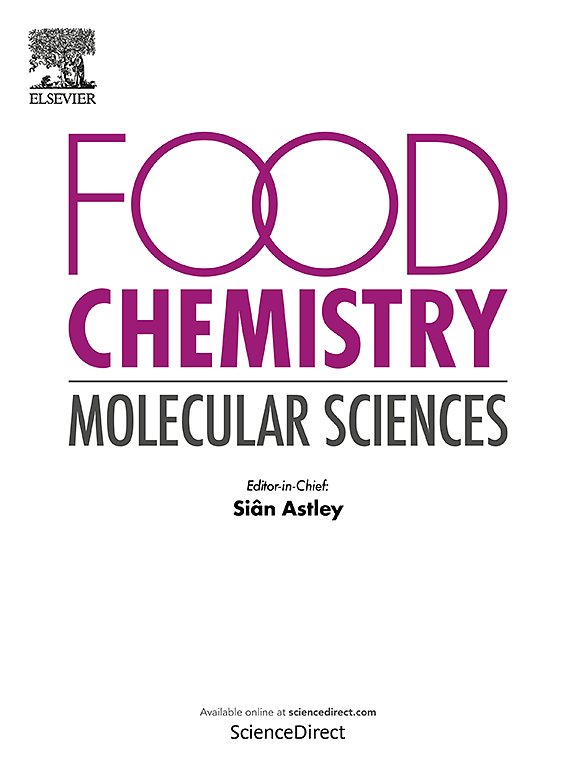鉴定微生物蛋白及自然发酵脉冲蛋白分离物中蛋白质组的变化
IF 4.1
Q2 FOOD SCIENCE & TECHNOLOGY
引用次数: 0
摘要
豆类是植物性蛋白质的可持续来源,但它们在感官属性和功能方面往往存在不足。发酵作为一种天然食品加工方法已被研究以解决这些限制。自然发酵是指原生微生物群在不添加特定微生物的情况下生长,传统上被世界各地的各种文化用于食品加工。然而,关于自发发酵过程中发生的蛋白质组成变化的知识差距仍然存在。本研究采用毛细管凝胶电泳和液相色谱-串联质谱联用技术,研究了鹰嘴豆、蚕豆和扁豆三种分离蛋白底物在自然发酵过程中蛋白质大小分布的变化,鉴定了微生物蛋白,并了解了蛋白质组水平的变化。结果表明,在所有底物中都鉴定出来自多种细菌和真菌物种的蛋白质,并且这些微生物蛋白质的数量和数量在自发发酵过程中增加。微生物蛋白质含量的增加与脉冲底物中蛋白质的水解有关,这可能会改变蛋白质成分的功能。本文章由计算机程序翻译,如有差异,请以英文原文为准。

Identifying microbial proteins and changes in proteome in spontaneously fermented pulse protein isolates
Pulses are a sustainable source of plant-based proteins, but they often fall short in terms of sensory attributes and functionality. Fermentation has been investigated as a natural food processing method to address these limitations. Spontaneous fermentation, where native microflora grow without the addition of specific microbes, has been traditionally used in food processing by various cultures around the world. However, there is a knowledge gap regarding the changes that occur in protein composition during spontaneous fermentation. This study used capillary gel electrophoresis and liquid chromatography coupled to tandem mass spectrometry to examine the changes in protein size distribution, identify microbial proteins and understand proteome-level changes that occurred during the spontaneous fermentation of three protein isolate substrates: chickpea, faba bean, and lentil. The findings revealed that proteins from a variety of bacterial and fungal species were identified in all substrates, and the number and quantity of these microbial proteins increased during spontaneous fermentation. This rise in microbial protein content was associated with the hydrolysis of proteins from the pulse substrates, which could potentially alter the functionality of the protein ingredient.
求助全文
通过发布文献求助,成功后即可免费获取论文全文。
去求助
来源期刊

Food Chemistry Molecular Sciences
Agricultural and Biological Sciences-Food Science
CiteScore
6.00
自引率
0.00%
发文量
83
审稿时长
82 days
期刊介绍:
Food Chemistry: Molecular Sciences is one of three companion journals to the highly respected Food Chemistry.
Food Chemistry: Molecular Sciences is an open access journal publishing research advancing the theory and practice of molecular sciences of foods.
The types of articles considered are original research articles, analytical methods, comprehensive reviews and commentaries.
Topics include:
Molecular sciences relating to major and minor components of food (nutrients and bioactives) and their physiological, sensory, flavour, and microbiological aspects; data must be sufficient to demonstrate relevance to foods and as consumed by humans
Changes in molecular composition or structure in foods occurring or induced during growth, distribution and processing (industrial or domestic) or as a result of human metabolism
Quality, safety, authenticity and traceability of foods and packaging materials
Valorisation of food waste arising from processing and exploitation of by-products
Molecular sciences of additives, contaminants including agro-chemicals, together with their metabolism, food fate and benefit: risk to human health
Novel analytical and computational (bioinformatics) methods related to foods as consumed, nutrients and bioactives, sensory, metabolic fate, and origins of foods. Articles must be concerned with new or novel methods or novel uses and must be applied to real-world samples to demonstrate robustness. Those dealing with significant improvements to existing methods or foods and commodities from different regions, and re-use of existing data will be considered, provided authors can establish sufficient originality.
 求助内容:
求助内容: 应助结果提醒方式:
应助结果提醒方式:


